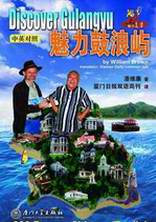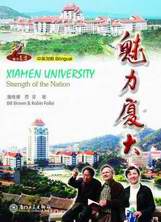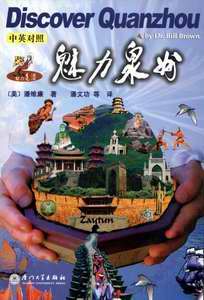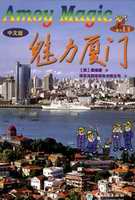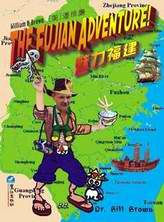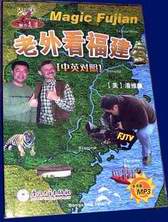![]() Click
to
Access
Click
to
Access
OUTSIDE China
![]() Click
to Access
Click
to Access
INSIDE
China ![]()
TRAVEL LINKS
![]() Xiamen
Xiamen
![]() Gulangyu
Gulangyu
![]() Jimei
Jimei
![]() Tong'an
Tong'an
![]() Jinmen
Jinmen
![]() Zhangzhou
Zhangzhou
![]() Quanzhou
Quanzhou
![]() Wuyi
Wuyi
![]() #1Fujian
Sites!
#1Fujian
Sites!
![]() Fujian
Foto Album
Fujian
Foto Album
![]() Books
on Fujian
Books
on Fujian
![]() Readers'Letters
Readers'Letters
![]() Ningde
Ningde
![]() Zhouning
Zhouning
![]() Longyan
Longyan
![]() Sanming
Sanming
![]() Putian
Putian
![]() Bridges
Bridges
![]() Travel
Info,
Travel
Info,
![]() Hakka
Roundhouses
Hakka
Roundhouses
![]() Travel
Agents
Travel
Agents
MISC. LINKS
![]() Amoy
People!
Amoy
People! ![]()
![]() Darwin
Driving
Darwin
Driving ![]()
![]() Amoy
Tigers
Amoy
Tigers
![]() Chinese
Inventions
Chinese
Inventions
![]() Tibet
in 80 Days!
Tibet
in 80 Days!![]()
![]() Dethroned!
Dethroned!
![]()
![]() Misc.Writings
Misc.Writings
![]() Latest
News
Latest
News
![]() Lord
of Opium
Lord
of Opium
![]() Back
to Main Page
Back
to Main Page
![]() Order
Books
Order
Books![]() Xiamenguide
Forum
Xiamenguide
Forum 
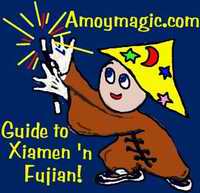
(Copyright
![]() Scott's
1st Xiapu Adventure!
Scott's
1st Xiapu Adventure!![]() Scott's
#4 Xiapu Adventure! 1996
Scott's
#4 Xiapu Adventure! 1996
![]() Scott's
5th Xiapu Adventure!
Scott's
5th Xiapu Adventure! ![]() Scott's
Photos!
Scott's
Photos!
Introduction by Bill Brown
(from 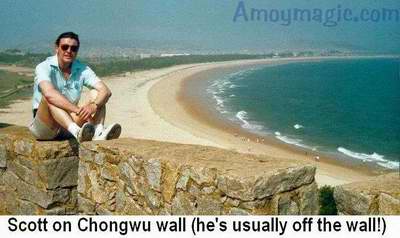 Mystic
Quanzhou--City of Light)
Mystic
Quanzhou--City of Light)
I am honored to end this book with an adventure written by one of Xiamen’s
most colorful characters, Scott Ballantyne. Granted, he’s an Englishman,
so he can’t speak or write standard American English, but he gets
his point across delightfully in spite of that impediment.
Scott Ballantyne came from UK to Xiamen in August 1995, bearing a degree in English Literature and an enthusiasm for adventure. For his first three years in Xiamen, he was a lecturer at Xiamen University and then, not being hindered by an American version of English, was recruited by the Swiss/Swedish conglomerate, ABB. Today, Scott is Sales Director for Global Sales and Marketing Manager.
All foreigners who have been here for a few years or more get asked the same question, “Why do you stay here?” and most of us give the same answer. Scott explained, “It is because every day I learn something new and interesting but as I learn I also help many people to understand the social and commercial differences between our cultures, and that is very, very rewarding.
Scott was instrumental in getting a whole village in north Fujian moved so that its children could go to school and so that its inhabitants and their descendants could live a better life. He rates this as the greatest achievement of his life. He has a book on learning English published in China and has written several novels and articles.
Having bought his own home in Xiamen, and married a local girl who didn’t mind a fellow who wore a skirt (Scott’s Scottish), he seems to have found his ideal place to settle.
Scott wrote an account of his Ningde experiences in my book “The Fujian Adventure,” and also a short piece for the last edition of Amoy Magic. I was delighted when he also agreed to write up his experiences in Quanzhou—never imaging it would take ten pages! As soon as I saw the length of his piece I got out the scissors—and then put them away. I present to you, unabridged (Quanzhou, forgive me!) Scott’s impressions of Quanzhou! Thank you Scott.
Enjoy!
Back to top (Or, if you're a brave soul, read on....!
Scott Ballantyne’s Quanzhou Adventure
If Bill is to be believed, Quanzhou is one of the best places in Fujian.
As Bill is the most authoritative person on Fujian Province that I know,
then he must be believed. However, when I visit Quanzhou, I find it hustle
and bustle, noisy and dirty – and if that’s what I want, I
just need to go to my kitchen (I’m joking, wife, I’m joking).
Actually, outside of Xiamen island, Quanzhou was the first place I ever
visited in China – way back in 1995.
When I arrived in China in August, 1995, it was to take up a post in Xiamen
University. There were a few others from USA and UK doing the same. After
a couple of months, the Foreign Affairs Office of the University arranged
a trip for the new foreign teachers (which they did a few times a year)
and the first of such trips was to be to Quanzhou and Chongwu. Our leader
for the trip was to be Alex, from the Foreign Affairs Office, and I think
it was the first time that he had taken charge of a group of foreigners
and I was convinced that he had been warned that if he lost, even one
of us, or if any foreigner came to harm, he would be immediately whipped
off to the Russian Front (which was especially bad as it didn’t
exist then). Poor Alex, he had no idea what he was in for, but fussing
around like an old mother hen was not the way to treat a bunch of academics
who had the spirit to find their own ways to China.
After he had counted us for the fifteenth time, he nervously ushered all
ten of his charges (all of whom, by the way, were much older than him)
onto the mini-bus (same as Bill’s Toy Ota) and we set off around
seven in the morning for the (then) arduous drive to Quanzhou. In 1995,
the Xiamen-Fuzhou highway, which goes via Quanzhou, did not exist, so
it was country roads for us.
Alex’s enthusiasm for the trip exceeded all expectations as he excitedly
pointed out things of interest to us on the way – things like, mountains
(which were really hills), cows, goats, peasants planting rice and the
odd jerry-built factories. Bottles of water were forced upon us at five-minute
intervals, and a variety of dried foods ensured we would stay alive and
he would avoid the Russian Front.
We arrived in Quanzhou very early in the afternoon and I remember thinking
how big it seemed compared to Xiamen. The roads were wide and very busy,
mostly with four-to-a-seat motorcycles (which I later learned were taxis).
Every driver of anything with wheels was making a noise, hooting horns
or ringing bells or just shouting. To say that it was vibrant would be
an understatement and it had about it a great sense of industry, not in
the factory way but in the way of busyness and commerce and bustle.
Back to top
Our host in Quanzhou was the impressive Overseas Chinese University and
we were taken straight there to unload ourselves, two-to-a-room in their
guest hotel. The rooms were large and comfortable and I was quite happy,
so far, with my first trip out of Xiamen.
After half-an-hour was permitted for us to unpack, we returned to the
car park to be multi-counted by Alex and ushered into the mini-bus but
not told where we were going, which is very much a Chinese characteristic
– to take you somewhere but not to tell you where you a going. It’s
a never ending Mystery Tour, and even requests of, ‘Where are we
going?’ get responses of ‘Never mind, you will like it.’
I think they are trying to build up suspense and make it exciting for
the unknowing visitor. Truth is, it usually ends up at a temple of some
sort or another. Quanzhou was no exception, except that the temple was.
I had already been very, very impressed by the Nan Putuo temple on Xiamen
island, but here was a worthy rival, Kaiyuan Temple. It was built around
the same time as Nan Putuo during the Tang Dynasty but is quite different
in its feel and surroundings. Where Nan Putuo has a slightly claustrophobic
feel due to its surrounding mountains and huge rocks, Kaiyuan feels open
and spacious. I particularly remember being fascinated by the two huge
pagoda’s which are about 800 years old. Actually, they are older,
from 600 to 700 AD, but the stone versions we can see today were built
in the 1200’s.
The bright afternoon when we visited, gave a perfect light to the carvings
on the pagodas and as I was walking around them, looking for the best
photo angle, I spotted a young local boy, sitting cross-legged with arms
folded in one of the lower-level alcoves, for all intent acting the part
of a god. As I pointed my camera towards him, he jumped down and ran away,
no doubt thinking that I would have some black-and white evidence of his
naughtiness.
We spent too little time at the temple before Alex gathered us together
and marched us, kindergarten-crocodile style, back to the bus, counted
us again and took us to the next leg of our Mystery Tour.
The next stop was to a museum which may now be incorporated into the Maritime
Museum, but at that time, was not. I am not sure if this is really the
case and memory betrays me of the name of the museum, but I shall call
it the ‘Deadhead Museum’ – just for want of a better
description.
Back to top
We were taken to a single storey building in which were housed a hundred
or so grave headstones. Wishing to leave all puns to Bill, I will avoid
the obvious. These pieces of stone were proudly exhibited in a form that
totally confused me and as the accompanying texts were in Chinese only
and our translator, Alex, used a moribund tone which he doubtless thought
appropriate, I quickly lost interest but found myself musing on what inspires
a person to even start a headstone museum. What kind of morbid quirk makes
people do such things? I mean, there were headstones from all over the
country and from different religions and with different kinds of carvings
and languages on them, which I am sure is interesting, but how do you
start to get fascinated by this? Perhaps my limited imagination is to
blame.
After half an hour of translating headstones, Alex realized that his only
audience had passed on centuries ago – every one else passing through
the exit doors. He rushed outside, counted us a couple of times and headed
us off to a bit of countryside.
There we found one of Quanzhou’s most famous landmarks – Lao
Zi – well, his statue, anyway. This huge stone figure of the founder
of Taoism totally dominates the countryside. There is a mountain behind
him but you do not see it beyond the imposing 5.5 meter carving. The other
noticeable thing about the Lao Zi statue, and just as interesting for
me in those early days in China, are the tour groups posing to have their
photos taken. Every group, no matter how large or small, poses in front
of anything remotely notable in China. These days, I watch with amusement
and try to guess how many of the posers will do so with the two-fingered
victory salute. There is always, always, at least one and usually many
more.
Not too far from the statue, we were taken to the small Muslim sacred
place of Lingshan, where we had a five-minute look at the tombs of the
Muslim Saints before being crocodiled back to the bus and back to Kaiyuan
temple and to the boat museum to see the restoration of a local Song Dynasty
boat (or ship – I never know what is the dividing line between those
titles – do you?). Today, the Maritime Museum is a must to visit,
but in 1995, it was not what it is today and ten minutes was all that
was required to see what it had to offer.
Back to top
I know that Bill will be covering in detail, and far better than I ever
could, all the historical places of interest in this area, and I, therefore,
make no attempt to compete with his knowledge and skill. So forgive my
brief and poor descriptions here.
Many years later, I was lucky enough to catch a Quanzhou puppet show.
It was unbelievable and something I would never forget. What I didn’t
realize back then in 1995, was how much I was missing when Alex apologized
to us because he had planned to take us to see the puppets, but on that
day they were out of town, or closed or being woodwormed or something.
Do not, when in Quanzhou, miss the puppets. That’s all I will say
on the subject.
As the Autumn light started to fade, we were taken back to the Overseas
Chinese University Hotel, for Alex’s favourite part of the day –
dinner time. A few local university dignitaries had been invited to join
us, so that we made up a comfortable group of two tables of ten. I found
myself seated on the same table as Alex and I knew, from previous experience
that Alex placed himself at the head of the food trough and that I was
gong to have to compete to survive the trip.
Seafood, as you have probably learned by now, is an important part of
diet in this part of China and Quanzhou is no exception. I cannot remember
what we ate that night, but I do remember competing with Alex for the
most delicious Xia – shrimp (or prawn – I never know what
is the dividing line between those titles – do you?!). In China,
where people can be very polite, Alex would be known as ‘strong’,
in the west, where we can be not so polite, he would be called ‘fat’.
Like the archetypical fat guy, Alex liked his food. Now, when it comes
to competing for Xia, the Chinese have a distinct advantage over us westerners.
You see, when I eat a prawn, or even a shrimp, I pull of its head, I fiddle
around with its legs until I can get them off with as much as the shell
as possible. Then, holding the fan tail, I scrape at the remnants of shell
until it is ready to go into the mixture of soy and vinegar which I prefer
as my little dish. After a little dunking in the soy vinegar, it goes
into my mouth.
The Chinese, however, do it differently. They take the prawn, dip it into
the soy or vinegar, put it into their mouths, jiggle their jaws around
a bit and wonderfully spit out the shell. It mesmerizes me how they do
it – I have tried many times and failed (I end up with shell on
my lungs) – but it does mean that they can eat prawns faster than
I can. Alex saw me as no competitor and he was right. So, at every opportunity,
I turned the lazy sally (the moving circular glass on the table) so that
the prawns were difficult for him to reach. That way, I got my fair share
of prawns – in fact, more than my fair share.
Back to top
During dinner, Alex hinted that he had a super surprise lined up for us
after dinner, but like the Mystery Tour, he would not tell us what it
was. Only when all food was demolished and all drinks drunk, did Alex
announce that he was taking us to a disco.
Perhaps it is difficult for you to imagine how ‘exciting’
that was for us. In Xiamen, at that time, there were no pubs or bars (apart
from the expensive bar in the Holiday Inn) and certainly no discos. In
fact, I believed at that time that discos were unknown in China. Yet,
here was Alex, promising to take us to one.
So, around nine o’clock, we were marched, single-file, by Alex,
to another building. All the way there, Alex kept saying to me, ‘Be
careful, it’s dark, be careful, it’s dark, be careful, it’s
dark.’ After a while of this, I replied, ‘Alex, it may come
as a surprise to you, but we have dark in England, too.’ He shut
up. Then, we arrived at a rooftop ‘disco’. It turned out to
be an open-air ballroom dancing evening to a few scratchy tunes recorded
onto a tape. The foreigners were a big attraction and expected to whiz
around the rooftop with a local beauty or two.
My prowess at waltz, tango, rumba or anything (except a smooch) that involves
dancing with my arms around a woman, is not something I excel at –
in fact, it terrifies me. I know that if ever I get forced into doing
it, the local hospital should stand by with medications for light bruising,
mild fractures or, if alcohol has been administered before dancing, then
even serious leg breaks. So, I spent two hours watching others enjoy themselves
while I refused ushering after ushering by everyone around me. I stubbornly
planted my feet apart and refused them any rhythm or movement. Quanzhou
residents may have concluded that Englishmen are killjoys had Prof. Charles
Tyzak, a fellow Englishman, not spent the rest of the night wafting, light-footedly,
around the rooftop dance floor.
Around 11pm, we braved the dark to be led, crocodile style, back to our
hotel and to bed. I was sharing a room with Charles that night and we
both got quickly off to sleep as we had an early start the next day for
Chongwu – the old walled city.
Back to top
Around three in the morning, my stomach prompted my bowels of some hyperactivity
headed their way. I found the bathroom, plonked myself on the toilet and
could still be found there, groaning at six when we were due to get up.
I informed Charles that I would not be leaving the toilet for the rest
of my life and for him and the others to continue to Chongwu, and everywhere
else without me. I was in agony.
‘You know,’ said Charles, knowingly, ‘I thought you
went a bit heavy on those prawns last night and that last one you had,
the big one, certainly looked suspicious to me – I thought you were
leaving it for Alex so I didn’t say anything, then it was too late.’
Thanks Charles.
He went down to breakfast promising to convince Alex
to let me stay in the bathroom (or at least the bedroom) for the rest
of the day. He failed.
‘No way Alex is going to let you stay here alone. What if something
were to happen to you?’ he asked.
‘The only thing worse than this pain would be death, and I don’t
mind that – I’m not afraid of it, I’m really not. Tell
Alex that. Tell him anything, but let me stay here.’ I pleaded.
He failed again and I was given a phial of charcoal pills, guaranteed
by Alex to cure me in an hour – they failed – and I took the
back seat of the bus, where I lay down and rolled around while the bus
took me groaning to Chongwu.
The road to Chongwu is quite good today, but in 1995 it was known locally
as ‘Abortion Road.’ Why? Well, any woman traveling on this
road who was pregnant from anywhere between 9 hours and 9 months would
have been rocked, rolled, jolted, shoved, shaken, bounced, roller-coasted
and stirred until no baby could have stayed inside.
The road was several hours of sheer misery, even for those not as afflicted
as I. When we thankfully arrived at Chongwu, everyone except me disembarked
for a few hours (which included a lunch I felt inclined to miss) to view
this ancient walled city by the beach. I saw none of it.
I slept for a while in the bus and prepared myself, at least psychologically,
for the return torture. When everyone got back to the bus, they insisted
on telling me what wonders I had missed and the sympathetic looks which
accompanied their comments told me they were telling the truth.
The following year,
I returned to Chongwu with a Chinese friend and was so glad I did. We
walked on the city wall and were invited into the city to drink some tea,
which we did. We strolled around the long, empty beaches and even had
a swim. Today, Chongwu has recognized its value as a tourist resort and
has changed much, but only on the outside. By that, I mean outside the
walls. Some interesting gardens and statues have been put there (which
I am sure Bill will describe in his book) and the area has generally been
cleaned up and tidied up a lot. It is clean and inviting and interesting.
Inside the walls, nothing has changed expect that the tourists cannot,
I believe, get in, they must view its occupants from the wall.
Back to top
However, on my last of many visits, a few months ago, I was allowed again
into the city and then I went to the beautiful beach where I watched,
fascinated, as the inhabitants took their boats and nets onto the sea,
rowed into the huge waves in a half circle, securing the nets on the start
of the journey and pulling in the other end on the return. Men, women
and children all helped to haul in the nets and recover the catch before
the men took the boats out again and again just as their forefathers had
done every day for the past several hundred years.
I wonder how many generations will continue this harvest method of fish
before tourism ranks more profitable and the old ways cease. It will surely
happen, but I can say that I witnessed it the way it has always, so far,
been. For that, I am eternally thankful.
The photograph at the beginning of this story shows me on the wall that
surrounds the town. Whenever I look at the beach behind me in the photo,
I think of Europe and how, with such a beach and such guaranteed sunshine,
it would be so full of people sunbathing that very little sand could be
seen. Perhaps such will happen at places like Chongwu and Xiamen, but
we are, at least, privileged to see it before it does happen. Enjoy every
moment of it while you can.
Back to top
![]() Favorite
Fujian Sites
Favorite
Fujian Sites ![]() Fujian
Foto Album
Fujian
Foto Album ![]() Xiamen
Xiamen
![]() Gulangyu
Gulangyu
![]() Fujian
Guides
Fujian
Guides ![]() Quanzhou
Quanzhou
![]() Zhangzhou
Zhangzhou
![]() Longyan
Longyan
![]() Wuyi
Mtn
Wuyi
Mtn ![]() Ningde
Ningde
![]() Putian
Putian
![]() Sanming
Sanming
![]() Zhouning
Zhouning
![]() Taimu
Mtn.
Taimu
Mtn. ![]() Roundhouses
Roundhouses
![]() Bridges
Bridges
![]() Jiangxi
Jiangxi
![]() Guilin
Guilin
![]() Order
Books
Order
Books
![]() Readers'
Letters
Readers'
Letters
Last Updated: May 2007
![]()
DAILY
LINKS
![]() FAQs
Questions?
FAQs
Questions?
![]() Real
Estate
Real
Estate
![]() Shopping
Shopping
![]() Maps
Maps
![]() Bookstores
Bookstores
![]() Trains
Trains
![]() Busses
Busses
![]() Car
Rental
Car
Rental
![]() Hotels
Hotels
![]() News
(CT)
News
(CT)
![]() Medical
& Dental
Medical
& Dental
![]() YMCA
Volunteer!
YMCA
Volunteer! ![]()
![]() XICF
Fellowship
XICF
Fellowship
![]() Churches
Churches
![]()
![]() Expat
Groups
Expat
Groups
![]() Maids
Maids
![]() Phone
#s
Phone
#s
EDUCATION
![]() Xiamen
University
Xiamen
University
![]() XIS(Int'l
School)
XIS(Int'l
School)
![]() Study
Mandarin
Study
Mandarin
![]() CSP(China
Studies)
CSP(China
Studies)
![]() Library
Library
![]() Museums
Museums
![]() History
History
DINING
![]() Restaurants
Restaurants
![]() Asian
Asian
![]() Veggie
Veggie
![]() Junk
Food
Junk
Food
![]() Chinese
Chinese
![]() Italian
Italian
![]() International
International![]()
![]() Visas
4 aliens
Visas
4 aliens
RECREATION
![]() Massage!
Massage!
![]() Beaches
Beaches
![]() Fly
Kites
Fly
Kites
![]() Sports
Sports
![]() Boardwalk
Boardwalk
![]() Parks
Parks
![]() Pets
Pets
![]() Birdwatching
Birdwatching
![]() Kung
Fu
Kung
Fu ![]() Hiking
Hiking
![]() Music
Events
Music
Events
![]() Festival&Culture
Festival&Culture
![]() Humor&
Humor&![]() Fun
Fotos
Fun
Fotos![]()
BUSINESS
![]() Doing
Business
Doing
Business
![]() Jobs!(teach/work)
Jobs!(teach/work)
![]() Hire
Workers
Hire
Workers
![]() Foreign
Companies
Foreign
Companies
![]() CIFIT
(Trade Fair)
CIFIT
(Trade Fair)
![]() MTS(Translation)
MTS(Translation)
![]()
Back to Top
